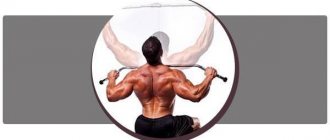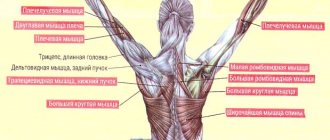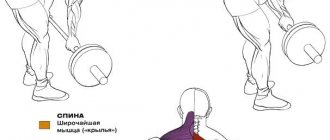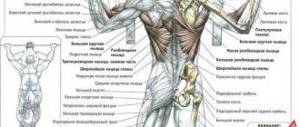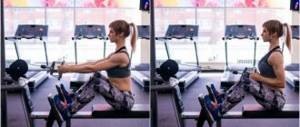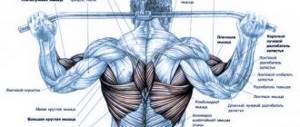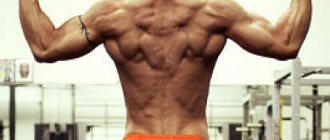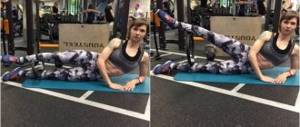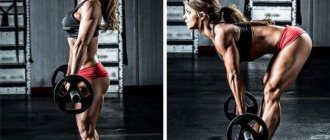Author: Timko Ilya - the ruler of the entire site and fitness trainer | more details >> Rod. 1984 Trained since 1999 Trained since 2007. Author and creator of the site tvoytrener.com. CCM in powerlifting. Champion of Russia and South Russia according to AWPC. Champion of the Krasnodar region according to IPF. 1st category in weightlifting. 2-time winner of the Krasnodar Territory championship in t/a. Author of more than 700 articles on fitness and amateur athletics. Author and co-author of 5 books.
Place in the author rating:
out of competition
(become an author) Date: 2012-05-29 Views: 881,892 Rating: 5.0
| All articles by the author >> | Medals articles >> |
Articles are loading...
| Article medals: | article in TOP 100 | more than 500 thousand views |
Why medals are given to articles:
| Bronze medal: | |
| 1. The article is in the TOP 100 2. The article has more than 3. The article has more than 100 | |
| Silver medal: | |
| 1. The article is in the TOP 50 2. The article has more than 3. The article has more than 500 | |
| Gold medal: | |
| 1. The article is in the TOP 10 2. The article has more than 1 3. The article has more than 1,000 | |
Main muscles - latissimus Additional - biceps and teres major Difficulty - medium
Barbell row to the belt, photo and technique
Take the barbell with a wide grip and remove it from the rack. Your hands should not be bent, your elbows should be out to the sides, your back should be straight, your legs should be slightly bent.
Then begin to pull the projectile towards your stomach, while trying to bring your shoulder blades together. Traction should be carried out precisely by the back muscles, and not with the help of the arm muscles.
Hold the barbell at the top point for exactly a second, then smoothly lower it, spreading your shoulder blades out to the sides and without changing the position of your back. Perform fifteen reps as a warm-up, followed by eight to ten reps of three or four sets with your working weight.
The popularity of bent-over rows
It is especially popular among experienced athletes. This is a consequence of the fact that bodybuilding, as a sport, is a branch of weightlifting, where free weights are mainly used.
This is also explained by the fact that in this exercise it is quite easy not to achieve stagnation. The longer the same exercise is used in the program, the faster muscle adaptation occurs. The best way to overcome this is to continually progress the load. As you perform, you will increase the working weights, and due to the high efficiency, you will easily achieve progress and muscle growth in your back.
Benefits of Exercise
The incline row has a number of undeniable advantages that set it apart from other back exercises. These include:
- This exercise works better than any other exercise on the thickness of the lats, since you use heavy weights in the workout;
- Develops overall body strength and endurance. As you progress in this exercise, you will also improve in other strength exercises, such as the deadlift or barbell press;
- Improves flexibility and mobility of joints;
- Bent-over rows improve your posture and help train your back corset muscles;
- Intense calorie burning. By involving a large number of muscles in the work, the exercise helps improve metabolism.
Due to the rather unusual and sometimes complex technique, this exercise is not very popular among gym goers. Although its effectiveness is much higher than that of analogous exercises performed in simulators.
Deadlift, its types
The deadlift is considered a basic exercise; the result of its regular implementation will be muscle growth, increased strength and proper muscle development, because it is the deadlift that will load many muscle groups.
The classic method of execution will help to work the following muscles:
- back muscles. With the classic version, the maximum load is received by the spinal extensors, especially the lower back; in addition, the latissimus muscles are also well worked out.
- muscles of the legs and buttocks. Regular deadlifts work the quadriceps, thighs, and glutes.
In the classic version, the following are additionally studied:
- forearms, hands;
- trapezoid;
- abdominal muscles;
- calves and inner thighs.
Deadlift technique
The most common way to perform a deadlift is the classic one. Before performing the exercise, warm up, then take an empty barbell, place your feet shoulder-width apart, try to keep your feet parallel. The pelvis is pulled back, the back is straight, you don’t need to lower your head too low, however, you shouldn’t raise your chin too high either.
Then lean forward, making sure your shoulders are slightly ahead of the level of the front of your shins. The legs in this position begin to bend involuntarily, which is normal. The tilt of your body should not exceed 40-45 degrees.
If the tilt is correct, your arms will be parallel to the level of your shins; in this case, there will be very little left to the bar. Crouching, grab the bar, trying not to tilt your body either back or forward. Your goal at this moment is to achieve a position in which your shoulders are vertical.
Slowly straighten your legs, then, without sudden movements, begin to straighten your back. By hanging the weights on the barbell, you won't have to bend down too low. This means you need to approach the bar so that the bar rests on your shin. In this position you should begin lifting the projectile.
Effective exercises at home for the whole bodyAbdominal vacuum exercise - instructions on how to do it correctly at home. All the subtleties and secrets from the pros + 100 photos
Machine leg extensions are the best technique for performing exercises in a sitting position. All the subtleties, secrets + instructions for you!
When straightening, try to bring your shoulder blades together. After this, begin to lower yourself, first by bending your back 45 degrees, and only then begin to bend your legs. You need to make sure that your shoulders are exactly under the bar.
Barbell deadlift
This exercise is performed with both a barbell and dumbbells. This requires a good level of stretching, so it’s best to work on it in advance.
Deadlifts are optimal for girls, since performing this exercise puts the main load on the muscles of the buttocks, lower back and back of the thighs.
When performing deadlifts with dumbbells, try to hold them so that the dumbbell bars are parallel to your feet.
If you haven't done enough stretching and you can't deadlift properly, try doing the Romanian deadlift. When performing this exercise, the pelvis should also be pulled back, but the legs are slightly bent, and the bar of the bar is lowered to the middle part of the shins.
How is it different from horizontal rods?
Unlike horizontal rows performed on block machines, bent over rows are performed with free weights. This allows you to engage many other muscle groups to maintain postural stability.
In addition, if we compare bent-over rows and horizontal block rows, in the first case we use maximum weights in a limited range of motion. When working with a barbell, you will use heavier weights than in machines. And this will already lead to a more intense increase in muscle mass.
You can do bent over rows with or without a belt. It is important to understand here that by working without a belt, you force the lower back muscles to work to maintain the correct body position. If you don’t have any back problems or you don’t use too much weight, then it would be preferable to exercise without a belt.
